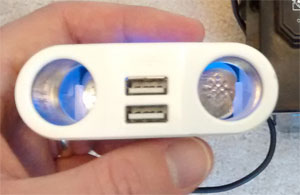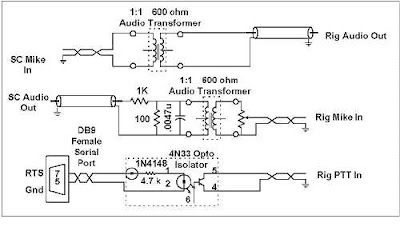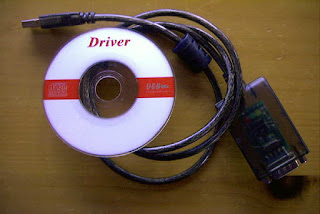 Friday afternoon pedestrian mobile QRP in a Moscow park
Friday afternoon pedestrian mobile QRP in a Moscow park
 Life is too short, that’s why in my opinion you should try to work QRP, hi!
Life is too short, that’s why in my opinion you should try to work QRP, hi!
This Friday afternoon me and my friend Stan UA3LMR (also RD2A) gave it a try again from Moscow park named “Fili,” a very nice and quiet place. This time my catch on the 20-meter-band wasn’t big at all in comparison with the previous outing which you can see in the video below.
Only two Russian stations from the Krasnodar region answered me during an hour and they were put in my log and then sent to the yearlong QRP marathon “Field Flowers.” An Italian ham didn’t make out my call, and New Caledonian’s didn’t ever hear my signal. Propagation and ultra low power are not only to blame. Probably during the work week is not the best time to find a lot operators working on the bands, on one hand. On another hand, the weekend’s bands are usually filled with contesters. What to do? To try whenever you can, of course.

In my point of view, the results of working QRP may sometimes be unlucky, but you will be always happy with the process!
73 and see you on the bands!
Peter R2ABT
Peter Dabizha, R2ABT, is a special contributor to AmateurRadio.com and writes from Moscow, Russia. Contact him romeo2abt@gmail.com.
 Amateur Radio Weekly – Issue 100
Amateur Radio Weekly – Issue 100
FCC seeks comments on lifetime Amateur Radio licenses
“The FCC would benefit by reducing administrative costs.”
ARRL
Heathkit introduces stealth 2m/440 antenna kit
Heathkit proclaims the antenna has multiple patents filed for many inventions in its design and is waterproof.
Radio Artisan
A field guide to the North American utility pole
We live under the umbrella of an intricate and fascinating web of infrastructure that enables every aspect of modern technology. But how often do we really look at it?
Hack A Day
Follow the 2016 Heard Island Expedition on WSPR
The VK0EK 2016 Heard Island Expedition will operate a 250-milliwatt battery-powered propagation beacon kit
VK0EK
A rant about working pileups – from both ends
If the NPOTA activator is calling for call area 4 – we should not hear call signs with 2s, 5s, or 7s.
W2LJ
The Hams of Hoover
Why does Bluff Park in Hoover, Alabama have a high concentration of radio amateurs?
Southgate
Post nuclear strike, Last Ditch Network ‘LDN’
The LDN or Last Ditch Network, was intended to be Regional Government’s last line of communication when all their landlines and associated backup radio paths had failed following a nuclear attack on the British Isles.
UKWMO Communications
Turning a marine battery into a massive emergency power source
To create my charging hub, I used a little Bestek splitter with two 12v sockets and 2 5v USB outlets.
amateurradio.com
Icom remote rig RS-BA1 IP software
The RS-BA1 allows you to access your ham shack rig at a distance, whether that distance is another room in your home or another country.
Icom
Video
What is inside an electrolytic capacitor?
A one minute teardown answering the question “What is Inside an Electrolytic Capacitor.”
ToddFun.com
Amateur Radio Weekly is curated by Cale Mooth K4HCK. Sign up free to receive ham radio's most relevant news, projects, technology and events by e-mail each week at http://www.hamweekly.com.
 Turning an RV marine battery into a massive 12-volt emergency power source
Turning an RV marine battery into a massive 12-volt emergency power source
 Every fall, I take the deep-discharge marine battery out of the pop-up camper and put it safely in the basement for winter storage. I’ve never used it for ham radio purposes, mostly because I’ve never needed it and it’s tied up for most of the summer.
Every fall, I take the deep-discharge marine battery out of the pop-up camper and put it safely in the basement for winter storage. I’ve never used it for ham radio purposes, mostly because I’ve never needed it and it’s tied up for most of the summer.
Recently we had a “long-ish” power outage (not uncommon during snowy, windy Maine winters). While we had plenty of heat from the fireplace, it didn’t take long for the batteries in our various phones and tablets to kick the bucket.
Luckily, Verizon’s data network is very robust and almost never goes down — even during extended power outages. Other than listening to the local ham radio repeaters and public safety scanner traffic, we rely on Internet access to check on power restoration and keep track of the weather.
I figured it was time to put that unused high-capacity battery to some good use in the off-season.
I decided to order a 12-volt plug socket with eyelet terminals. There were quite a few choices on Amazon but the reviews of the NOCO GC018 struck me as particularly good and I didn’t have to wait for it to arrive from China. The price was right at just under $7 shipped (with Prime) and 232 great reviews didn’t hurt, either.
I wasn’t familiar with the NOCO brand, but what immediately impressed me was how well made it was. It feels like it will last awhile and the connections are very solid. The 3/8″ eyelets aren’t flimsy and they’re low-set to minimize bending. Unlike other options, it has an in-line 15A blade-type automotive fuse which I usually keep on hand. The fuse is well-protected from moisture and the socket has a durable end cap.
I wouldn’t plug a 100w HF rig into the socket, but a 25w mobile radio should’t draw more than 10 amps. A small “pocket-sized” 175-watt inverter would work great with this setup.

To create my charging hub, I used a little Bestek splitter with two 12v sockets and two 5v USB outlets (one 1.0A, the other 2.1A). I would’t use it to power anything with a substantial current draw, but it works great for charging multiple low-power devices. While a 12-volt cigarette lighter socket isn’t the best connector around, it’s the defacto standard for 12-volt consumer devices. Just don’t charge the deep-discharge battery indoors!

My rough math says the battery should be good for well over 150 hours of continuous phone charging. That should last us for most any power-free scenario short of complete and utter societal breakdown — and if that’s the case, I probably won’t be needing my cell phone!
What does your household emergency power setup look like?
Matt Thomas, W1MST, is the managing editor of AmateurRadio.com. Contact him at editor@amateurradio.com.
 TX Factor Episode 10
TX Factor Episode 10
The long-awaited tenth episode is finally here.
Mike Marsh returns to his old school in Ottery St Mary, Devon to learn how science lessons have changed since he was a lad.
Bob keeps his feet firmly on the ground in his native Cornwall to see why the letter ‘K’ has been making its presence felt. While he’s there, he visits Goonhilly Earth Station to meet Arthur, the satellite dish that made history in the early 1960s and its modern-day equivalent.
Steve Venner G0TAN shows us the ins and outs of the Yeasu FT-991 all-band transceiver.
And the folks at TX Factor make a plea for help.
Hope you enjoy it!
73
TX Factor Team
Nick Bennett 2EØFGQ co-hosts TX Factor with Bob McCreadie GØFGX and Mike Marsh G1IAR. Contact the team at info@txfactor.co.uk
 USB PTT Line Keying
USB PTT Line Keying

Back in 2007, when I first experimented with single-yagi 2m moonbounce, I constructed an interface that would allow my aging laptop to communicate with my equally aging Icom 821 transceiver.
Back then, the shack's old Toshiba laptop (running Win98SE) had a serial (RS-232) communications port and my homebrew interface would let the WSJT software key the PTT line, as well as handle the required 'in' and 'out' audio.
 |
| My Homebrew Radio-Computer Interface |
 |
| Courtesy: KK7UQ |
The 2m Icom has no audio VOX , so to key the radio via the WSJT audio tones, I would need to build a simple VOX system that would key the PTT-line. All things being equal, I didn't really like this idea since it would likely result in 'hot-switching' of the changeover relays and eventually lead to problems.
I investigated the alternative method of hard keying the PTT via the USB port, using a USB-to-serial port adapter, but these were not entirely without problems either. It seems that certain chipsets were worse than others but the FTDI style were less prone to compatibility problems.
I also considered purchasing a Signalink USB interface which would take care of the PTT keying as well as the audio. After researching the Signalink, I found some disturbing reviews that indicated the onboard sound card could create some significant signal-to-noise degradation when used for weak-signal work ... such as EME. The generated noise would likely never be noticed when used on the noisy HF bands, which probably accounts for most Signalink applications, but on weak-signal moonbounce, every db is precious and an elevated noise floor from the sound card would definitely not be helpful.
Further research indicated a really nice line of interfaces being built by Johnny, G3LIV. He offers several models to suit various needs and none seem to include a sound card, which would eliminate the possibility of unwanted noise being introduced ... but before making a decision, I made one final attempt at finding a cheaper solution.
An E-Bay search for an FTDI USB serial port adapter brought up several offerings worldwide, with the majority being in the far east. I found one promising looking low-volume dealer in China, that not only offered the device for $11.99 with free-shipping, but also had a 100% feedback rating and no complaints, ever! What the heck. It was the right chipset, assuming it wasn't counterfeit, the price was right and the dealer looked to be doing his best to offer a good product ... I placed the order and three weeks later the adapter arrived.
The adapter was well packaged and included a small CD containing the necessary USB drivers for several different operating systems, including my newer laptop's Windows 7.
I plugged the adapter into an empty USB2 port and sent the device manager to search the CD for the needed files, which it quickly found and installed. The software created a virtual serial port, assigning the adapter to COM port 3. I then set the WSJT switching tasks to COM3 and connected my homebrew interface to the adapter via its DB9 serial connector. To see if the new adapter would really work, I instructed WSJT's JT65B software to turn on the transmitter before sending a test tone, which hopefully would key the PTT line ... and it did! It seemed that my $11.99 investment was doing the job perfectly. Thankfully, none of the online horror stories that I had encountered regarding USB serial port adapters, had been encountered.
If you need something of this sort, I can recommend this particular product as well as the E-Bay seller. If you are starting from scratch, the entire interface could be easily built, using new parts, including the USB adapter, for just a few dollars and I may, in fact, re-package everything into one compact box, USB adapter and all.
But hold on ... I think I see a big bright moon rising at the moment ... (cont'd)
Steve McDonald, VE7SL, is a regular contributor to AmateurRadio.com and writes from British Columbia, Canada. Contact him at ve7sl@shaw.ca.
 Ham Talk LIVE! Episode 2 – Don Wilbanks, AE5DW
Ham Talk LIVE! Episode 2 – Don Wilbanks, AE5DW

Ham Talk LIVE! Episode 2
w/ Don Wilbanks, AE5DW
Amateur Radio Newsline and Ham Nation
Thursday, 25 February 2016
9:00 PM Eastern Time (02:00 UTC)
Listen to this episode LIVE (and to all previous episodes) in the player below:
[spreaker type=standard width=620px autoplay=false show_id=1607081]
Matt Thomas, W1MST, is the managing editor of AmateurRadio.com. Contact him at editor@amateurradio.com.
 Some Radio Antics
Some Radio Antics
Thankfully things calmed down and was able to put the antenna back up but I seemed a little deaf on VHF/UHF dropping several S-points on local repeaters and then started to see high VSWR readings. The incessant rain had somehow got into the connector under the collinear despite being generously wrapped in self amalgamating tape. I replaced the connector and removed a couple of feet of coax in case any had seeped into the cable.
Like much of the UK amateur community I have been trying to listen in to British Astronaut Major Tim Peake during a number of ARISS UK school contacts during the Principia mission on the International Space Station. It is pleasing to see the enthusiasm, interest and publicity it has generated for the hobby.
There is another contact tomorrow (Friday 26th February 2016 at 1440UTC) with the City of Norwich School. While reception of the first two contacts proved a little disappointing for me, the one last week was much better and I made a video during the pass.
The Astronauts are certainly busy on the space station and there was an ARISS contact this morning with an Italian school. It was a low pass here only reaching 7 degrees above the horizon but was pleased to capture Tim Kopra conversing. I was using just the X-50 collinear on the FT857-D
The repaired ATU and a new balun on the OCFD has made a big difference to HF. It is much less noisy and I am now able to match the antenna to 80m something I could never do before. While it will be very inefficient on such a short antenna I did run a little over 2W last night on WSPR as a test, and was pleasantly surprised.
I have also been doing some JT65 and for the first time some JT9 inspired by a demonstration at SKARS and I was pleased to make a JT9 QSO with JA5BDZ on 15m using 10W.
A big help to HF has been tracking down the source of my recent QRM, which wasn't as many suggested my evil PLT devices but in fact the now redundant wireless router. While the WiFi was switched off it was still being used as a network switch and for some reason had suddenly become RF noisy, it wasn't the switching PSU but the actual unit and would happen a few hours after being switched on. Funny thing it is not the first time I've had an access point suddenly emit QRM.
A couple of weeks ago I went out with Stewart (M0SDM) to assist him flying his kite antenna and we operated under the club callsign MX0SKR, for a couple of hours, it was great fun.
Last weekend I also helped my brother David (M6GTD) install a couple of antennas at the family home. He can finally use the radio he brought at the Hamfest back in September, a Diamond X-50 dual band collinear and a home brewed 33ft long OCFD should get him on the air!
David helped me at the Hamfest with the balloon launch
My apologies if this blog post sounds like a bit like an excited child recanting his holiday "I did this, and then I did this and I also did that" I hope to post something a little more coherent and structured soon!
Andrew Garratt, MØNRD, is a regular contributor to AmateurRadio.com and writes from East Midlands, England. Contact him at nerdsville@gmail.com.




















